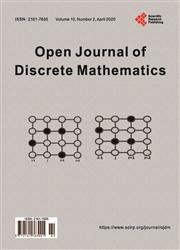Do Almost All Trees Have No Perfect Dominating Set
引用次数: 0
Abstract
A graph G is said to have a perfect dominating set S if S is a set of vertices of G and for each vertex v of G, either v is in S and v is adjacent to no other vertex in S, or v is not in S but is adjacent to precisely one vertex of S. A graph G may have none, one or more than one perfect dominating sets. The problem of determining if a graph has a perfect dominating set is NP-complete. The problem of calculating the probability of an arbitrary graph having a perfect dominating set seems also difficult. In 1994 Yue [1] conjectured that almost all graphs do not have a perfect dominating set. In this paper, by introducing multiple interrelated generating functions and using combinatorial computation techniques we calculated the number of perfect dominating sets among all trees (rooted and unrooted) of order n for each n up to 500. Then we calculated the average number of perfect dominating sets per tree (rooted and unrooted) of order n for each n up to 500. Our computational results show that this average number is approaching zero as n goes to infinity thus suggesting that Yue’s conjecture is true for trees (rooted and unrooted).几乎所有的树都没有完美的支配集吗
如果S是G的顶点集合,并且对于G的每个顶点v,要么v在S中,v不与S中的其他顶点相邻,要么v不在S中,但只与S中的一个顶点相邻,那么我们就说图G有一个完全控制集S。图G可以没有一个,一个或多个完美控制集。判定图是否有完全支配集的问题是np完全的。计算任意图具有完美支配集的概率问题似乎也很困难。1994年,Yue[1]推测几乎所有的图都没有完美的支配集。本文通过引入多个相互关联的生成函数,利用组合计算技术计算了n阶树(有根树和无根树)中每个n≤500的完美支配集的个数。然后,我们计算了每棵树(有根和无根)的n阶完美支配集的平均数量,每个n到500。我们的计算结果表明,当n趋于无穷时,这个平均值接近于零,这表明Yue的猜想对树(有根和无根)都是正确的。
本文章由计算机程序翻译,如有差异,请以英文原文为准。
求助全文
约1分钟内获得全文
求助全文

 求助内容:
求助内容: 应助结果提醒方式:
应助结果提醒方式:


